It’s November and I’ve never seen so many butterflies in Harlingen’s Hugh Ramsey Nature Park!
First Fridays (from now through May 2019) begin at 9 a.m. with a Guided Native Plant Walk around Ebony Loop — a one-quarter mile, level caliche trail in the above mentioned park.
Every month is different because of what goes on in secret between the park’s habitat and the various elements of the Valley’s weather — rain, drought, dry, humid, wind, storms, floods, cool, heat — you get the idea.
October is generally the Valley’s “Butterfly Explosion” month, so much so that nature centers on the Island celebrate butterflies during “Hallo-Wings” events close to Hallowe’en.
This year — just a few short days away from November — there was hardly a colorful wing in the sky on SPI.
And then, the universe apparently became aligned because by the first weekend in November — VOILA! Blooms galore, and thousands of butterflies during the early morning nature walk.
For every mosquito — and there were many — there were at least 100 butterflies. Butterflies of all shapes, colors and sizes — large giant swallowtails, big yellow sulphurs (Phoebes), rectangular shaped chocolate-brown sickle-winged skippers, iridescent-glowing golden-edged white peacocks, vibrant-colored bordered patches, and cinnamon-bright Mexican fritillaries to tiny whites, blues, checkerspots, skippers and beyond.
Ebony Loop was a veritable butterfly gala between Butterfly Meadow and the Laughing Garden at Ani Cut.
The path into Butterfly Meadow garden– where nectar-rich Cortes, Torrey and low crotons eagerly await — was impassable, guarded as it was by so many mosquitoes. What was noticeably missing were dragonflies. Dragonflies would have made short shrift of the mosquito population but nary a one did we spy.
Nectar was abundant enough along the trail, and we didn’t miss a beat after frantically fleeing Butterfly Meadow’s mosquito ambush. We’d only hung around the entrance long enough to determine that the adaptive Tamaulipan olive, Cordia alba, would soon be in full bloom.
The Tamaulipan olive, with its clusters of yellow-blooming flowers, is something you’ll want to see if you haven’t already. It, and the native wild olive, Cordia boissieri, guard the entrance to Butterfly Meadow; both are important nectar sources for butterflies.
Here are the blooms the butterflies were swarming along Ebony Loop:
Crucita (fall-blooming mistflower) (Chromolaena odorata) — rated excellent as a nectar source
Lantanas — Texas (Lantana urticoides), Velvet (Lantana velutina) and West Indian (Lantana camara) — all rated excellent
Frostweed (Verbesina microptera) — rated as very good nectar source
Skeleton leaf golden eye (Viguiera stenoloba) — a good rating as a nectar source
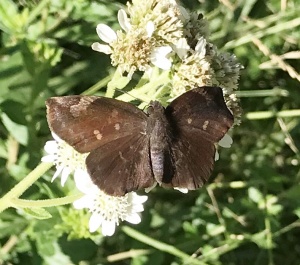
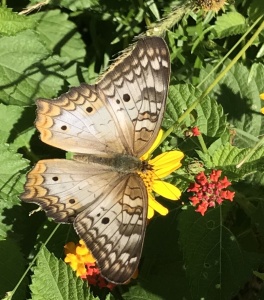
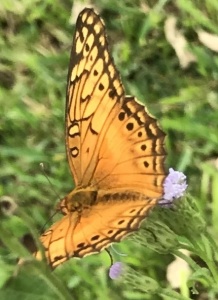
Butterflies tend to sleep in, coming out enforce when the sun gets strong, about mid-morning. My 9 – 11 a.m. Guided Native Plant Tour arrived at Butterfly Meadow at 10 a.m. — right on time for the amazing butterfly show.
At home, I have four healthy stands of mistflower. One stand is betony leaf mistflower, (Padre Island mistflower) Conoclinium betonicifolium, with its fleshy, oblong, crinkle-cut-edged leaves. The other three are huge stands of crucita (fall blooming mistflower), Chromolaena odorata.
Adjacent to one stand is frostweed, Verbesina microptera.
In another area, I’ve allowed two large crucita to take over the edge of a butterfly garden.
In a fourth area, a lovely West Indian lantana (Lantana camara) is as massive as its crucita companion. Near the two plants, a climbing hemp weed (Mikania scandens) — page 113, Dr. Albert Richardson and Ken King’s Plants of Deep South Texas — has vined through a black willow at the resaca edge. The PDST lists climbing hemp weed as an important nectar plant to butterflies.
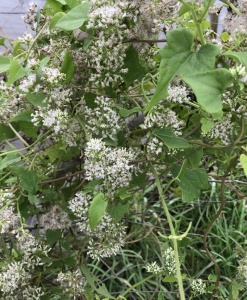
Here’s what I’ve observed since August: Of all the numerous species of butterflies that have visited my property, I’ve not seen any butterflies on the climbing hemp weed, very few on the lantana camara, three on the frostweed and one on my skeleton leaf golden eye. As for the stands of crucita — every day, they are positively laden with butterflies of all sizes, shapes and colors.
I was very glad to witness the Ebony Loop butterflies using every available nectar offering. As for my yard, I’ll continue giving the butterflies a great smorgasbord of plants; if they don’t enjoy the variety, I certainly do.
Here’s a new visitor to my crucita this week. I assumed it was a longtail, but I don’t find one with these specific markings in my butterfly reference books, nor one that is this rich, velvety, deep-dark brown. I’d be happy to hear from you if you can identify this butterfly.
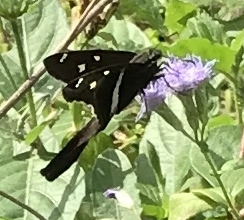
Along with First Friday Guided Native Plant Walks around Ebony Loop in Harlingen’s Hugh Ramsey Nature Park, we offer the same on Third Saturdays through May 2019. The walks are from 9 to 11 a.m. We meet at the far end of the parking lot. Just show up — no reservation necessary. You might want to bring your own bug spray and water. It’s an easy walk and there are plenty of benches along the route.
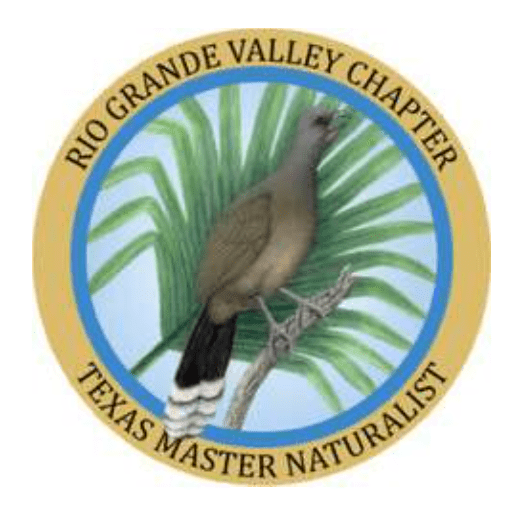
Leave a Reply